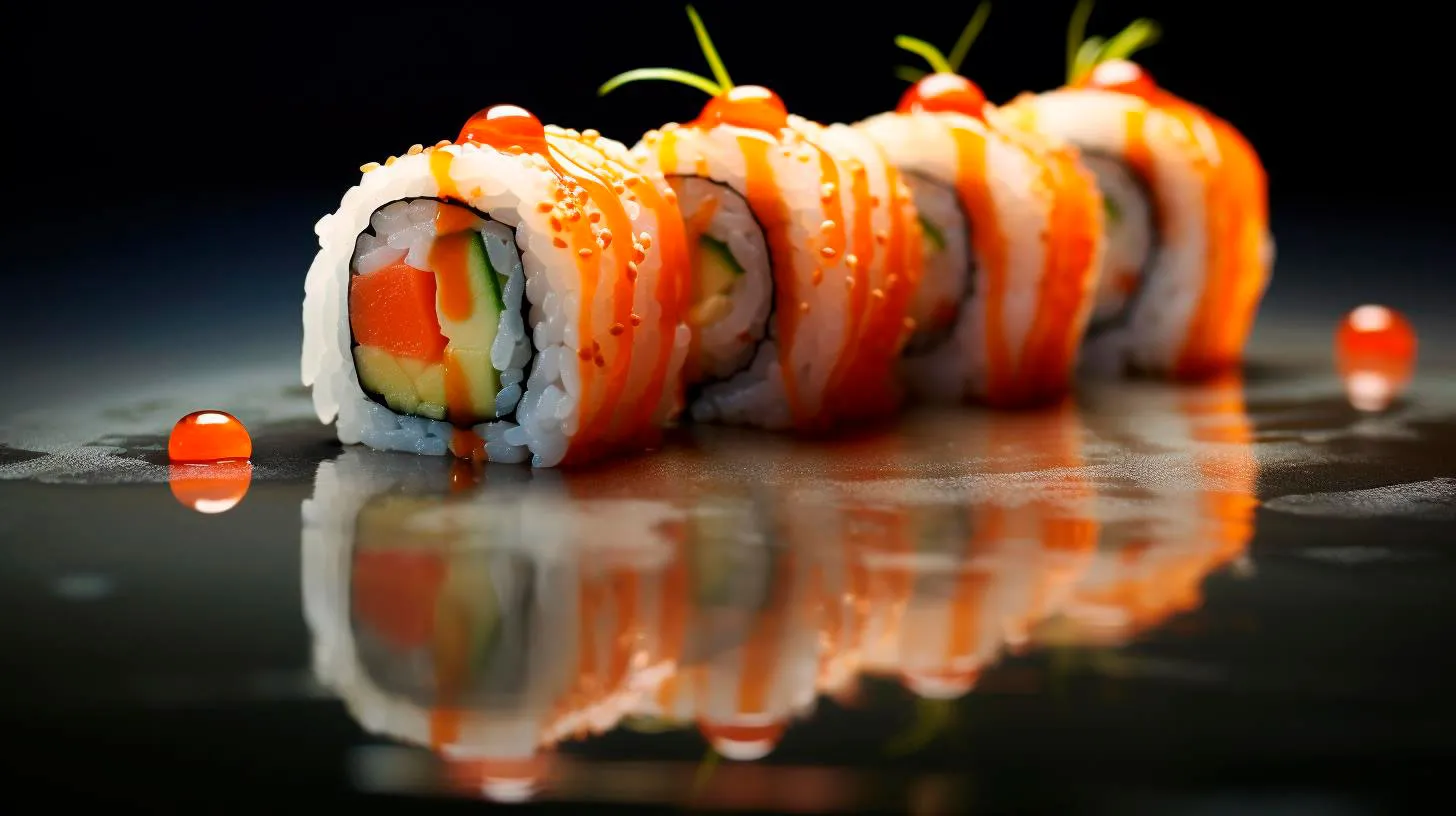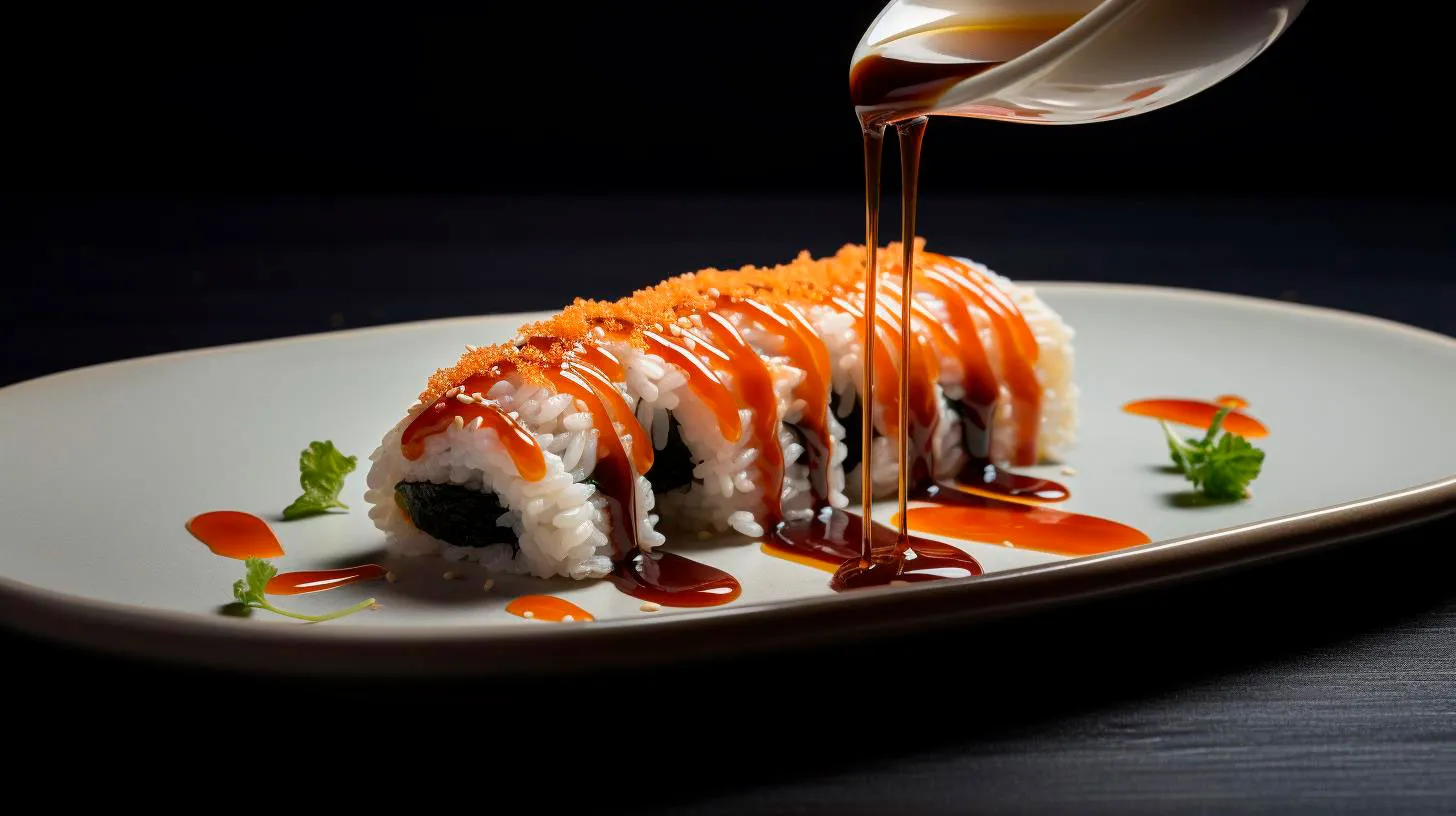Unveiling the Intricate Relationship Between Sushi and Traditional Japanese Culture
Not only is it a delicious delicacy, but it also embodies the traditions, history, and artistry of Japan. Let’s dive deeper into the intricate relationship between sushi and traditional Japanese culture.
The Origins of Sushi
Sushi, in its most basic form, is a combination of vinegared rice and various ingredients such as fish, vegetables, and seafood. While it may seem simple, the creation of sushi dates back centuries and was initially developed as a way to preserve fish. The rice acted as a natural fermentation agent, allowing the fish to be stored for extended periods without spoiling.
Over time, sushi evolved into an art form. Skilled sushi chefs carefully selected the freshest ingredients and crafted beautiful combinations that delighted the senses. Each piece of sushi became a work of edible art.
The Influence of Japanese Culture
The relationship between sushi and Japanese culture goes beyond mere sustenance. It is deeply rooted in the values and customs of Japan. Here are some key aspects that highlight this connection:
- Aesthetics: Japanese culture places a strong emphasis on aesthetics, and sushi perfectly exemplifies this. From the elegant presentation of each roll to the delicate balance of flavors, sushi represents the harmony and attention to detail that is deeply embedded in Japanese art and design.
- Seasonality: In the traditional Japanese culinary tradition, seasonal ingredients play a significant role. Sushi chefs incorporate ingredients that are at their peak during specific times of the year, ensuring the freshest and most vibrant flavors in every bite. This connection to nature is deeply ingrained in Japanese culture.
- Precision and Craftsmanship: Japanese culture values precision and craftsmanship, and sushi preparation is no exception. Sushi chefs undergo years of training to perfect their skills. From the way they slice the fish to the meticulous shaping of the rice, every step is executed with precision and utmost care, reflecting the dedication to mastery that is highly valued in Japanese culture.
- Simplicity: While sushi embodies complexity in its preparation, it also embraces simplicity in its ingredients. Each piece of sushi typically consists of just a few elements, allowing the natural flavors to shine. This minimalistic approach reflects the Japanese concept of “less is more” and the appreciation for purity and simplicity that permeates their culture.
The Impact of Sushi on Japanese Culture
Sushi has not only influenced Japanese culture but has also made a significant impact on the world stage. Here are some key takeaways that highlight its influence:
- Sushi has become synonymous with Japanese cuisine globally, attracting tourists and food enthusiasts from around the world. In fact, sushi restaurants can now be found in nearly every corner of the globe, transcending cultural boundaries.
- Traditional sushi bars, known as “sushi-ya,” offer an authentic experience that showcases the artistry and craftsmanship behind this beloved delicacy. Visitors get the chance to witness firsthand the skillful techniques employed by sushi chefs.
- The popularity of sushi has led to the integration of Japanese ingredients and flavors in a variety of cuisines worldwide. Fusion sushi rolls, incorporating ingredients like avocado, cream cheese, and spicy mayo, have become a hit, showcasing the versatility and adaptability of Japanese cuisine.
- Through the practice of sushi-making, Japanese culture promotes mindfulness and appreciation for every aspect of the dining experience. From the careful selection of ingredients to the rituals observed during a traditional sushi meal, it encourages individuals to slow down and savor the moment.
Intricacies That Go Beyond Food
The relationship between sushi and traditional Japanese culture goes beyond the realms of food. It extends to a deeper understanding of Japan’s customs, values, and art forms. Exploring the world of sushi allows individuals to immerse themselves in the rich tapestry of Japanese culture.
Key Takeaways:
- Sushi represents the harmony, precision, and simplicity deeply ingrained in traditional Japanese culture.
- The aesthetics, seasonality, and craftsmanship behind sushi reflect core aspects of Japanese values and customs.
- Sushi has had a significant impact globally, attracting tourists and integrating Japanese flavors into various cuisines.
- Discovering the world of sushi unveils a deeper appreciation for the intricacies of Japanese culture.
As you enjoy your next plate of sushi, take a moment to reflect on the incredible journey of this beloved delicacy and the cultural connections it holds. It truly is a testament to the artistry and traditions of Japan.
The History of Sushi: From Ancient Origins to Modern Delights
Join us on a journey through time as we explore the fascinating origins of sushi and how it has evolved into the beloved dish we know today.
Ancient Origins
Surprisingly, sushi wasn’t always the bite-sized treat we enjoy today. Its roots can be traced back to 2nd-century China, where it began as a method of preserving fish. In an era without refrigeration, fermenting fish with salt and rice allowed people to store and consume it over an extended period. This preserved fish would be served with rice, but the rice was later discarded as it was only used for preservation purposes.
Fast forward to the 8th century, and sushi had made its way to Japan. Japanese chefs began experimenting with the fermentation process, opting to keep the rice rather than discard it. During the Muromachi period (1336-1573), a new technique called narezushi emerged, where raw fish was layered with fermented rice and left to age for several months. This technique gave birth to the distinctive sour flavor that is still present in some traditional sushi dishes today.
Edo Period and the Rise of Sushi
It was during the Edo period (1603-1868) that sushi transformed into the form we recognize in modern times. As Japan embraced peace and prosperity during this era, the bustling city of Edo (now Tokyo) became a hub of cultural and culinary innovation. Street food stalls, known as yatai, dotted the city’s busy streets and offered a variety of dishes, including sushi.
Chefs began to experiment with fresh, seasonal ingredients to create a new type of sushi known as nigiri-zushi. Instead of fermenting the fish, they served it fresh, placing small slices atop hand-pressed vinegared rice. This new technique not only preserved the flavors and textures of the fish but also significantly reduced the preparation time, making sushi more accessible and appealing to the masses.
Sushi Goes Global
While sushi gained popularity within Japan during the Edo period, it took several more decades for the dish to make its way overseas. It wasn’t until the late 19th century when Japan opened its doors to the world that sushi began its global journey.
Initially, sushi was introduced in the United States in the early 1900s, but it wasn’t until after World War II that its popularity skyrocketed. American soldiers stationed in Japan developed a fondness for the dish and brought their newfound appreciation back home. In the 1960s, sushi restaurants started popping up in major American cities, and soon, sushi bars became fashionable dining establishments, catering to both locals and curious food enthusiasts.
Modern Sushi Delights
Today, sushi has become a global sensation, with countless variations and styles enjoyed around the world. From traditional nigiri-zushi to the modern California roll, it seems there’s a sushi creation to please every palate.
One of the key advantages of sushi is its versatility and health benefits. With a focus on fresh and raw ingredients, sushi is packed with essential nutrients, including omega-3 fatty acids and minerals. It’s also a low-calorie option, making it a great choice for those watching their waistlines without compromising taste.
Furthermore, sushi has become synonymous with meticulous craftsmanship and culinary artistry. Skilled sushi chefs spend years perfecting their techniques, ensuring that each piece of sushi is a work of art. The elegant presentation of sushi is a feast for the eyes, making it the perfect dining experience for those seeking both taste and visual delight.
Key Takeaways
- The history of sushi dates back to ancient China, where it was initially used to preserve fish.
- In Japan, sushi evolved during the Edo period with the introduction of nigiri-zushi, which is popular even today.
- Sushi gained global popularity after World War II, with the United States at the forefront of its popularity.
- Modern sushi delights offer a wide range of options, from traditional nigiri to creative rolls.
- Sushi is a nutritious and low-calorie option, perfect for health-conscious individuals.
- The artistry and presentation of sushi make it a visual treat, enhancing the overall dining experience.
So, the next time you savor a piece of sushi, take a moment to appreciate the centuries of history and cultural innovation that have made it the beloved dish it is today. From its humble origins as a preservation method to its global popularity, sushi continues to captivate our taste buds and inspire new culinary experiences.
Sushi: A Symbolic Dish Celebrated at Japanese Festivals
Not only is sushi a culinary masterpiece, but it is also deeply rooted in Japanese culture, particularly celebrated during traditional festivals. In this article, we will delve into the intriguing world of sushi and explore its significance as a symbolic dish during Japanese festivals.
The Origins of Sushi
Before we dive into the festival traditions surrounding sushi, let’s take a brief journey into its origins. Dating back to the 8th century in Southeast Asia, sushi was originally developed as a means of preserving fresh fish in fermented rice. Over time, this preservation process evolved into what we now know as sushi. The dish gained immense popularity in Japan during the Edo period (17th to 19th century), where sushi chefs perfected their techniques and elevated sushi to an art form.
Sushi as a Symbol of Celebration
Japanese festivals, known as matsuri, are vibrant and joyful events that bring communities together to celebrate various occasions. Sushi plays a vital role during these festivities, symbolizing prosperity, authenticity, and reverence for tradition. Let’s explore how sushi is integrated into these cultural celebrations:
1. Bon Festival
The Bon Festival, held in mid-August, is a time for Japanese people to honor their ancestors and commemorate the spirits of the deceased. Sushi, particularly inari-zushi (sushi rice wrapped in sweet tofu pouches) and chirashizushi (scattered sushi), is offered as an ancestral tribute during this festival. Additionally, families often gather to make sushi together, forming a strong sense of familial unity.
2. Hinamatsuri
Also known as the Doll Festival, Hinamatsuri is celebrated on March 3rd and is dedicated to young girls. Sushi, typically temari-zushi (hand-rolled sushi balls), adorns the vividly decorated ceremonial stands during this festival. The colors and shapes of the sushi represent good health, happiness, and fortune for the girls.
3. Setsubun
Setsubun marks the beginning of spring and is a festival celebrated on February 3rd. During this event, people partake in eating ehomaki, a special sushi roll filled with various ingredients such as tuna, cucumber, and egg. The act of consuming the entire roll, facing a specific direction representative of the current year’s zodiac animal, is believed to bring good luck and drive away evil spirits.
The Advantages of Sushi during Festivals
Sushi’s presence during Japanese festivals brings several advantages beyond its symbolic significance. Let’s examine some of the key benefits:
- Diversity: Sushi offers an array of options, accommodating various dietary preferences and restrictions. From vegetarian rolls to seafood delights, there is something for everyone to enjoy.
- Convenience: Sushi is portable and easy to handle, making it an ideal festival food. Its compact size and neat packaging allow people to savor its flavors while participating in festive activities.
- Freshness and Healthfulness: Festivals are often held during seasons abundant with fresh ingredients. Sushi, emphasizing the use of seasonal seafood and vegetables, provides festival-goers with a nutritious and healthy dining option.
- Cultural Immersion: By indulging in sushi during Japanese festivals, visitors can truly immerse themselves in the country’s rich cultural heritage. It offers an opportunity to experience traditional flavors and customs firsthand.
Key Takeaways
Sushi, beyond its culinary excellence, carries immense symbolism and cultural significance during Japanese festivals. Understanding the traditions associated with this beloved dish allows us to appreciate the depth of Japanese culture and its connection to food. Remember these key takeaways:
- Sushi is a traditional dish deeply rooted in Japanese culture.
- Sushi plays a significant role during Japanese festivals, symbolizing prosperity and tradition.
- At festivals such as Bon Festival, Hinamatsuri, and Setsubun, sushi is featured as an offering and a delicacy.
- Benefits of sushi during festivals include its diversity, convenience, freshness, and cultural immersion.
Next time you have the opportunity to enjoy sushi, whether at a festival or your local sushi bar, savor the flavors and appreciate the cultural heritage within each delicate bite.
From Local Delicacy to Global Phenomenon: The Evolution of Sushi
The Origins of Sushi
Sushi originated in Southeast Asia around the 4th century BC and was initially a method of preserving fish by fermenting it with rice. This technique was brought to Japan by Buddhist monks and quickly gained popularity among the Japanese people.
At first, sushi was mainly consumed as street food and was considered a fast and affordable meal option. It was not until the 19th century that sushi started to be served in formal restaurants and gained recognition as a gourmet dish. The creation of the nigiri sushi style, where a piece of raw fish is placed on top of a small rice ball, revolutionized sushi presentation and elevated its status as an exquisite cuisine.
The Rise of Sushi in the West
In the mid-20th century, sushi began to make its way to the Western world. Initially, it was met with skepticism and hesitation due to the unfamiliarity of raw fish as a main ingredient. However, as international travel and cultural exchanges increased, sushi gained traction and started to be recognized as a delicacy outside of Japan.
In recent years, sushi has exploded in popularity, particularly in urban areas. Its healthy and fresh ingredients, coupled with its visually appealing presentation, have made it a favorite choice for many food enthusiasts. The rise of social media and food blogging has also played a significant role in showcasing sushi’s beauty and uniqueness to a global audience.
The Health Benefits of Sushi
Sushi is not only delicious but also offers several health benefits. Here are some key advantages:
- Rich in Omega-3 Fatty Acids: Fish used in sushi, such as salmon and tuna, are packed with omega-3 fatty acids, which promote heart health and help reduce inflammation.
- Low in Calories: Sushi rolls, like maki rolls, are generally low in calories, making them a popular choice for those watching their weight.
- High in Nutrients: Sushi contains a variety of vegetables that provide essential nutrients like vitamins, minerals, and antioxidants.
These health benefits have contributed to sushi’s popularity as a go-to option for those seeking a nutritious yet flavorful meal.
Key Takeaways and Future Trends
The evolution of sushi from a local delicacy to a global phenomenon has been nothing short of remarkable. Here are some key takeaways:
- Sushi originated in Southeast Asia and was later brought to Japan by Buddhist monks.
- It started as a humble street food and gradually gained recognition as a gourmet cuisine.
- Sushi faced skepticism in the West initially but has now become a popular international cuisine.
- Its health benefits, including omega-3 fatty acids and low-calorie options, make it a favorite choice for health-conscious individuals.
Looking into the future, the popularity of sushi is expected to continue growing. As more people become aware of its delicious taste and health benefits, sushi may further permeate international culinary scenes. Additionally, the fusion of sushi with other cuisines and the introduction of new ingredients can add exciting dimensions to this already diverse and versatile dish.
So, the next time you enjoy a plate of sushi, remember its incredible journey from a local delicacy to a global phenomenon. Savor each bite and appreciate the cultural exchange that brought it to your table.


